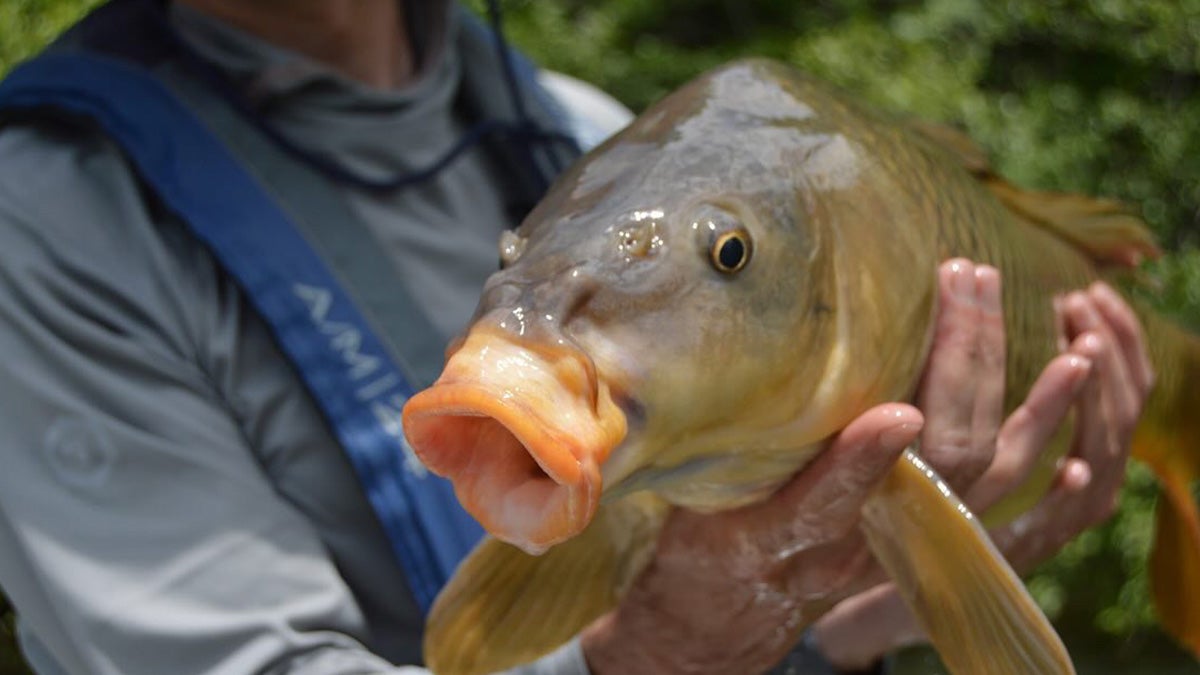The Cicada Report: Southeast Anglers Are Crushing Carp on Brood XIX Bugs

An angler holds up a carp caught on a cicada fly in Southeast Tennessee. The Hatch Outfitters
Cicada chaos is underway in the Southeast. Swarms of Brood XIX cicadas are covering up long stretches of brush in large portions of the south. Videos of these loud bugs are making their way around social media, and anglers in the area are already taking advantage of this massive cicada emergence—experiencing excellent success while targeting bluegill, bass, and carp.
Right now, carp is king as far as cicada fishing goes. The poor man’s bonefish are cruising shorelines with overhanging brush, looking for fallen cicada bugs. Fly anglers are seeing big fish come up and suck down the giant flies. We spoke with Seth Fields, the owner of The Hatch Outfitters in Chattanooga, Tennessee, about what his guides and clients are seeing on the water. And we picked his brain about the best time to fish and useful tactics for the remainder of the hatch.
Clockwise for top: An angler holds up a massive carp; an angler with a carp caught on a cicada fly; a cicada perched on overhanging brush. The Hatch Outfitters
Field Report: Southeast Tennessee
The cicada hatch is in full swing all throughout the Tennessee Valley. According to fly shop owner and guide Seth Fields, the Chattanooga area and Tennessee Gorge are flush with bugs everywhere you look. “Our entire area is covered up in cicadas on just about any patch of land in Chattanooga,” he says. “You can hear them along our lakes and motor up to about any shoreline and find bugs.” Fields, who is a diehard carp angler, says that they’re about two weeks into the hatch and are hoping for at least another two weeks of bugs emerging, hopefully more.
The biggest struggle anglers are facing right now in the immediate Chattanooga Tennesse River drainage, which includes areas like Watts Bar Reservoir, Lake Chickamauga, and Nickajack Lake, is water clarity. The stained water from recent storms is making it difficult for fish to key in on bugs, but there are still cicadas everywhere on the water. Anglers looking to target bass, bluegill, and other sunfish can experience excellent fishing right now in the area. The carp fishing is tougher, but as the water clears up, it will only get better.
All of that said, anglers don’t have to travel far to find clear water and phenomenal cicada fishing. “Some of the bigger reservoirs just north of us are getting the same amount of bugs, if not more,” says Fields. “They’ve got clear water, and the fishing is incredible. It isn’t uncommon for each angler to catch up to 15 carp in a day.”
While Fields and his guides are seeing trout, bass, and other species eat cicadas, the best action is coming by targeting carp. Fields and his team of guides at The Hatch Outfitters are running cicada-specific trips right now. Be sure to call the shop for booking details.
Tips for Targeting Carp on Cicadas
If you’re in the southeast Tennessee area, you will want to find lakes and reservoirs with wooded steep banks. Here, bugs can easily fall off tree branches and brush and plop right into the water. Unlike traditional carp fishing, where anglers focus on super skinny water, cicada fishing is completely different. Carp will be cruising these cutbanks and structure edges that are often up to 12 feet deep, looking for bugs on the surface.
“We’re seeing them high in the water, even swimming with their backs out of the water sometimes,” says Fields. “They’re eating bugs left and right, but clear water is the big defining factor for success.”
Fields says it’s best to go as realistic as possible when it comes to flies. Fish are already being pressured and beginning to refuse flies. Make sure to bring a variety of bugs and stock up on realistic patterns like the Project Cicada.
“We’ve been noticing carp even refuse real cicadas that have their wings tucked in on the water,” says Fields. “But when bugs would land with their wings out wide, fish would come up and gulp them instantaneously.” Fields has adjusted by splaying the wings on his flies so they’re out to the sides when they land on the water. Make sure to observe how actual bugs look in the water and how fish are reacting to them. You’ll have to adjust to fish behavior, especially as the hatch continues and pressure increases.
Fields is hoping for another two to four weeks of bugs emerging in the area, but anglers to the north who aren’t seeing bugs yet should start seeing and hearing cicadas any day now. Stay tuned for more live reports in the coming weeks.
The post The Cicada Report: Southeast Anglers Are Crushing Carp on Brood XIX Bugs appeared first on Field & Stream.
Articles may contain affiliate links which enable us to share in the revenue of any purchases made.
